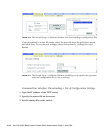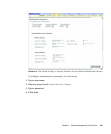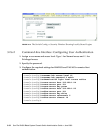
3-34 Sun Fire B1600 Blade System Chassis Switch Administration Guide • June 2003
Equipment commonly managed with SNMP includes switches, routers, and host
computers. SNMP is typically used to configure these devices for proper operation
in a network environment, as well as to monitor them to evaluate performance or
detect potential problems.
The blade system chassis switch includes an on-board SNMP agent that
continuously monitors the status of its hardware and the traffic passing through its
ports. A network management station can access this information using software
such as Solstice Domain Manager. Access rights to the on-board agent are controlled
by community strings. To communicate with the switch, the management station
must first submit a valid community string for authentication. The options for
configuring community strings and related trap functions are described in the
following sections.
3.2.7.1
Configuring SNMP Access
You can configure up to five community strings authorized for management access.
For security reasons, consider removing the default strings.
When configuring SNMP community strings using the web interface or CLI, the
following parameters can be configured:
■ Community – A password (between 1 and 32 characters, which is case sensitive)
that permits access to the SNMP protocol. The default community strings are
public (read-only access) and private (read/write access)
■ Access Level
■ Read Only – Read-only access. Authorized management stations are able to
only retrieve MIB objects.
■ Read/Write – Read/write access. Authorized management stations are able to
both retrieve and modify MIB objects.
Web Interface: Adding and Removing Community Strings
1. Open the Switch Config ⇒ Communication window.
2. Type the new community string
in the String text field.
3. Select the access rights from the Access Level pull-down menu.
4. Click Add.


















